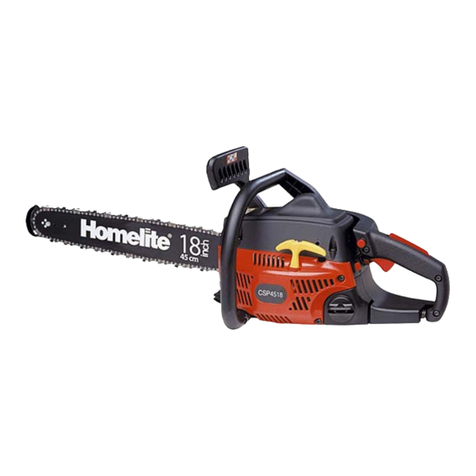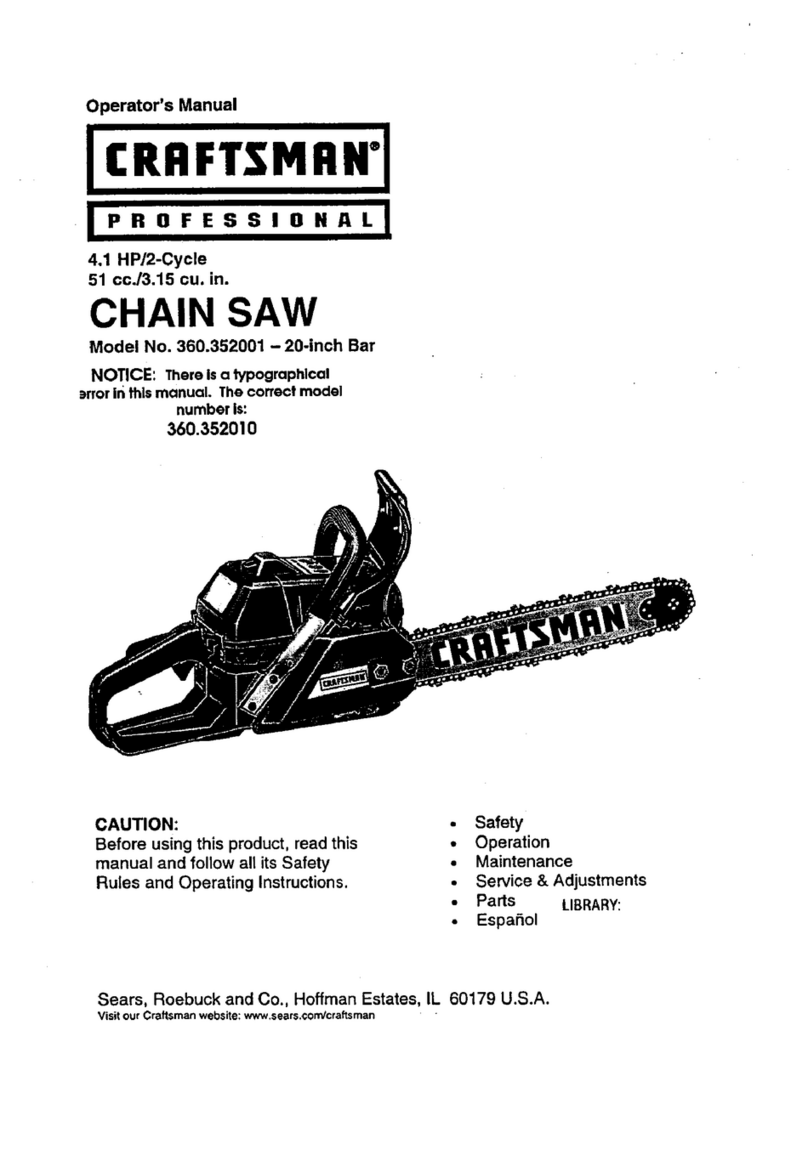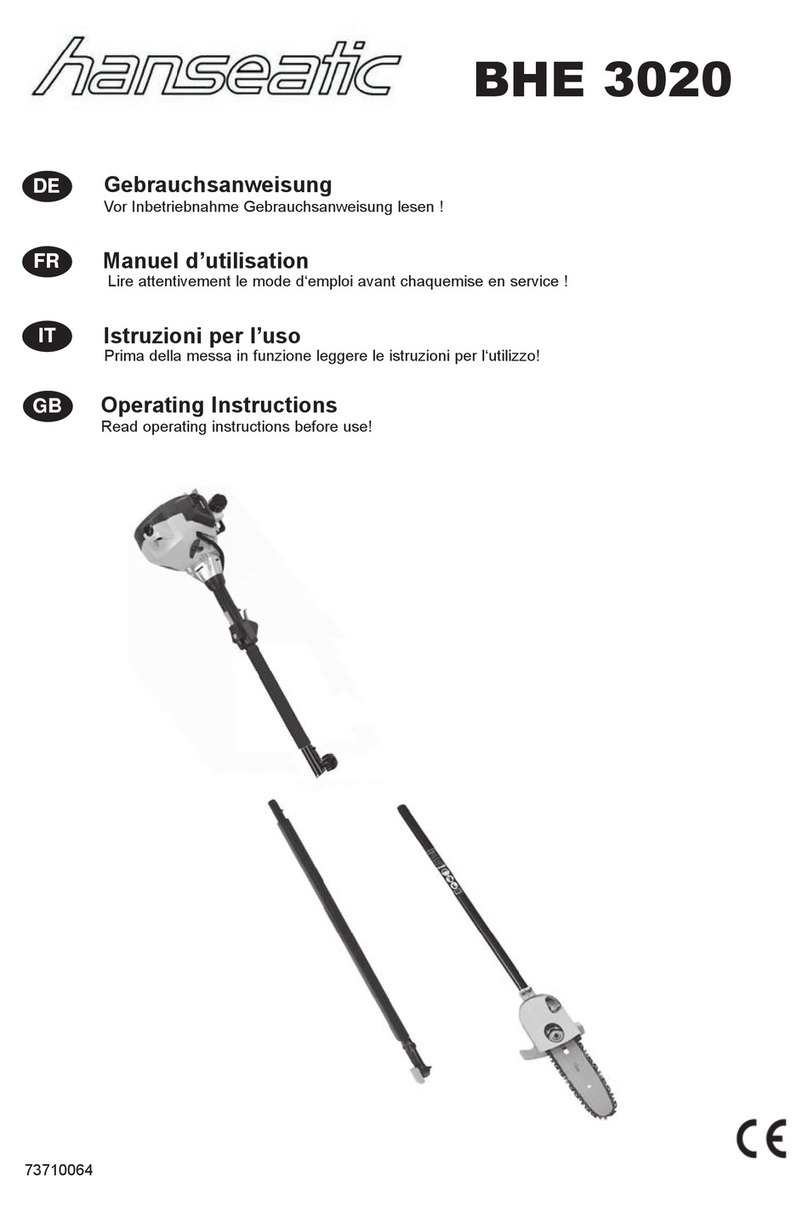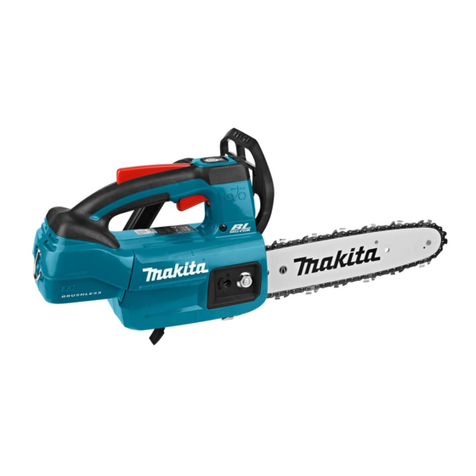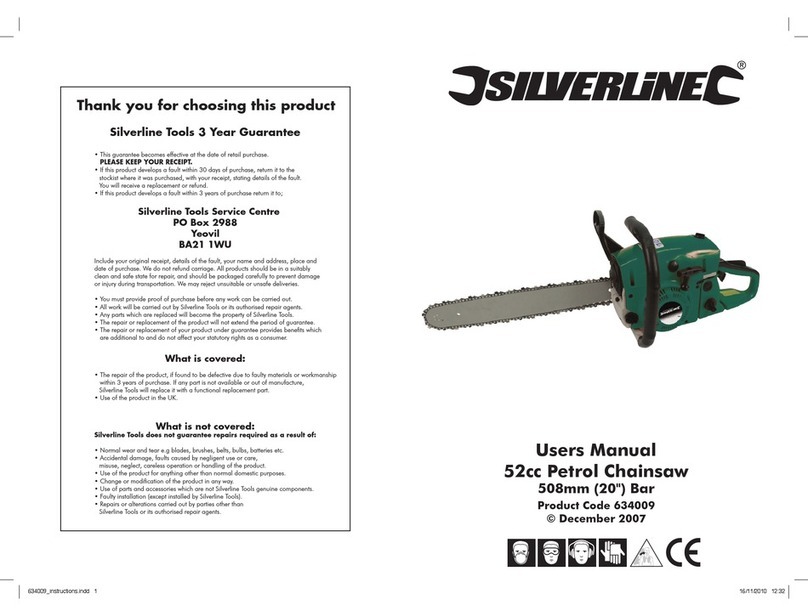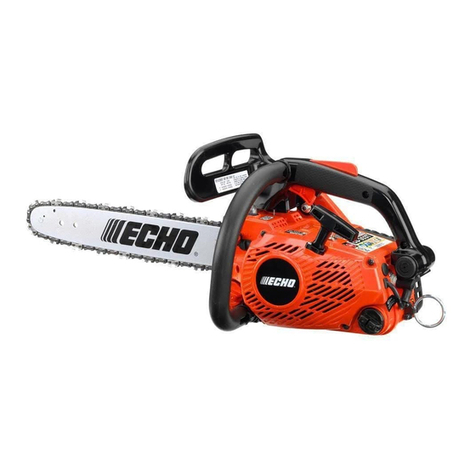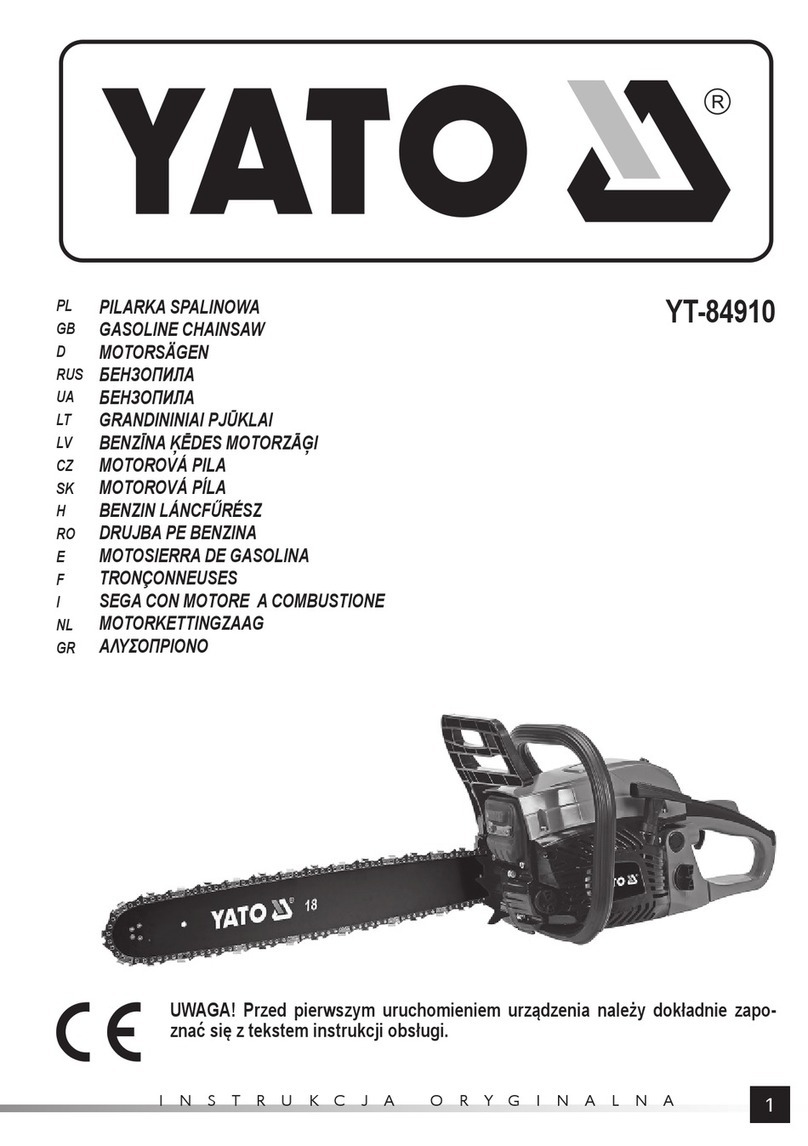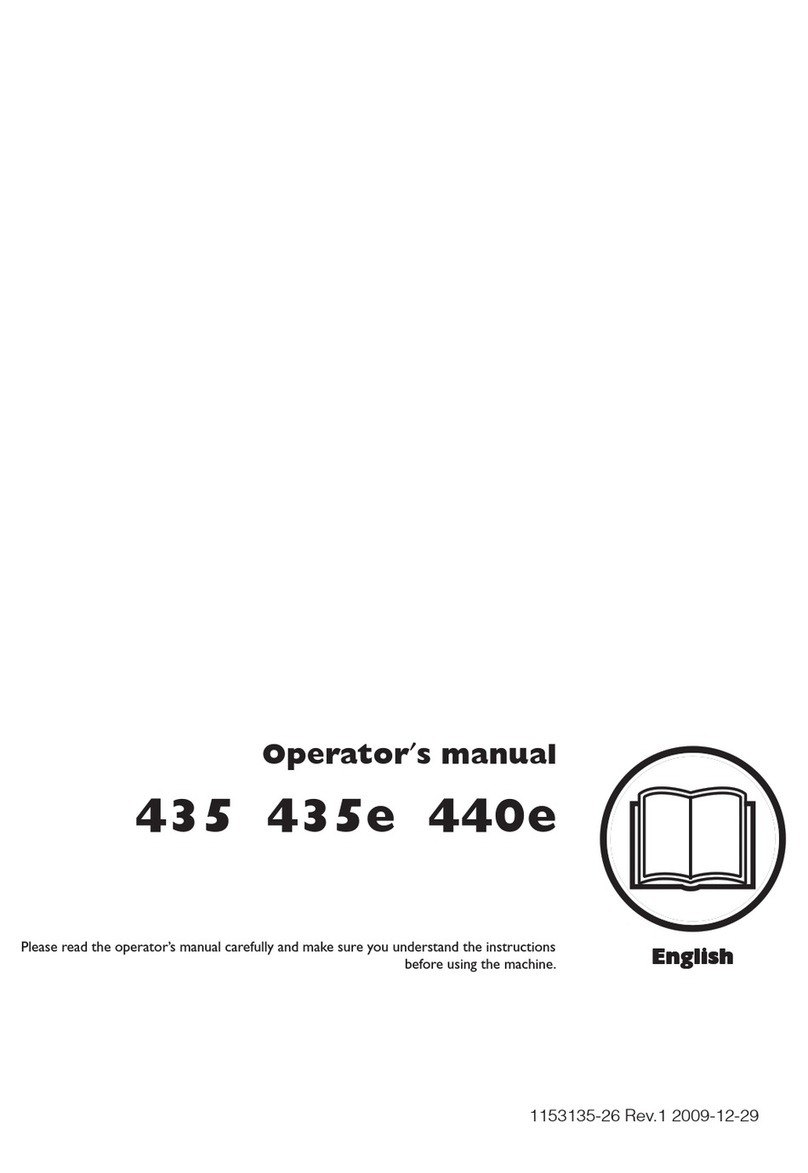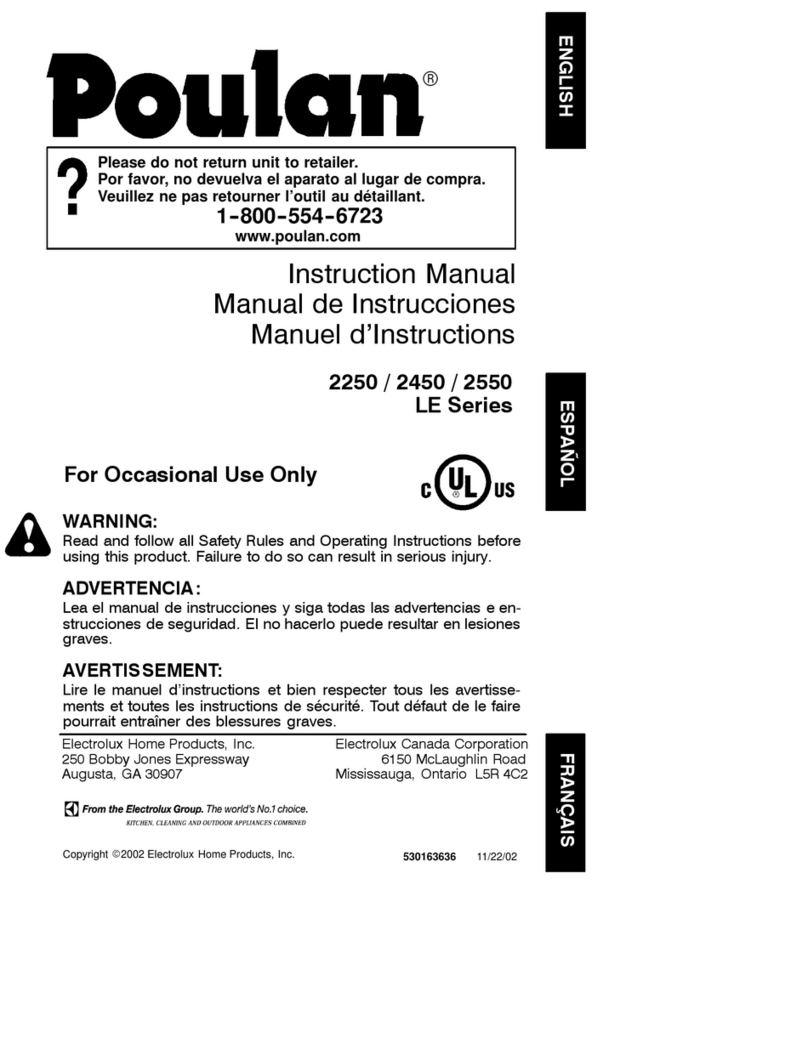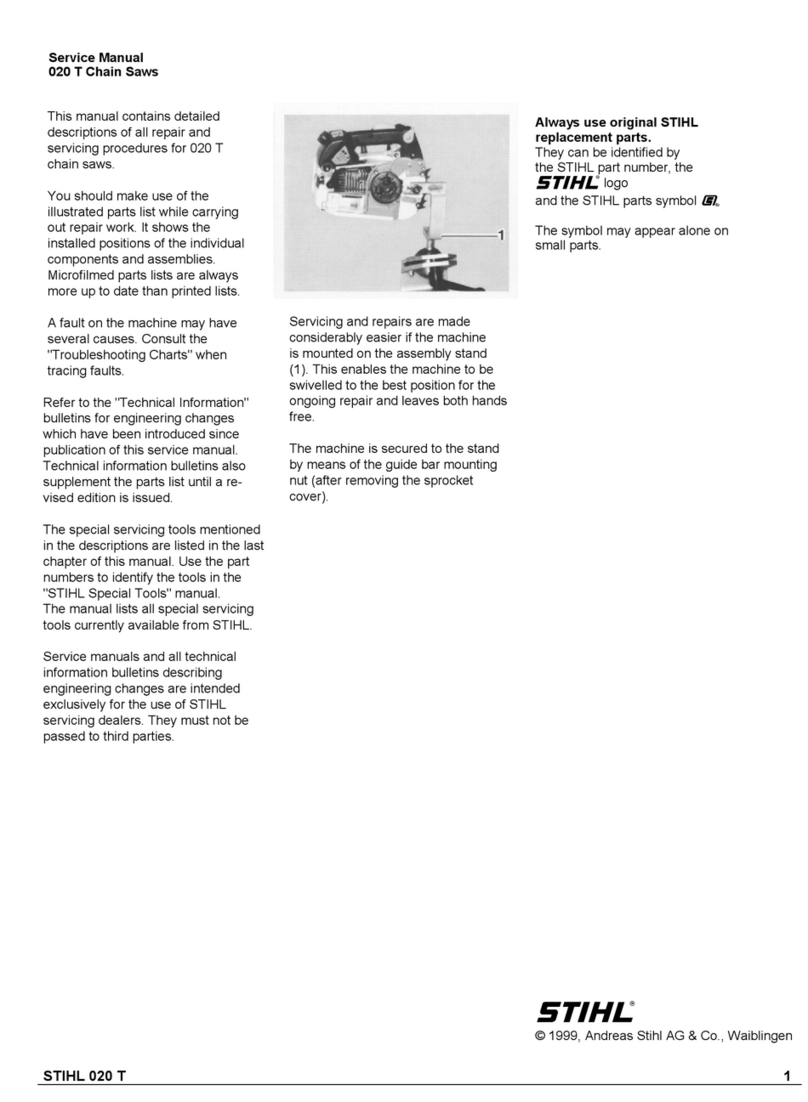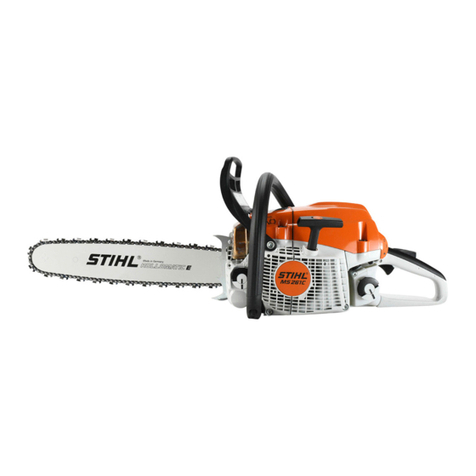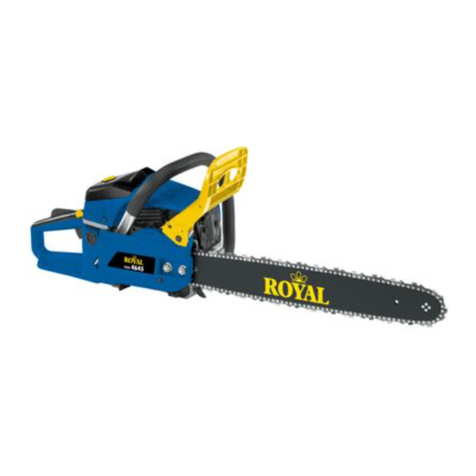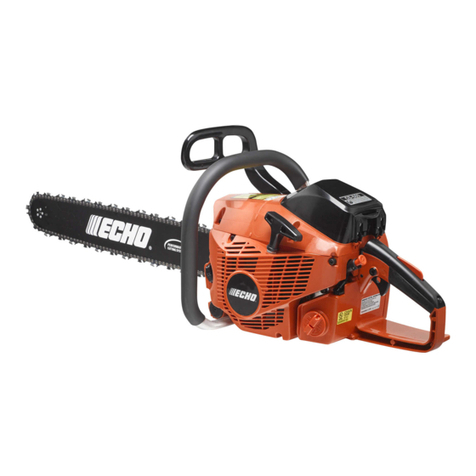Efco Power MTT 3600 Assembly instructions

OPERATOR’S INSTRUCTION MANUAL
MANUEL D’UTILISATION ET D’ENTRETIEN
MANUAL DE INSTRUCCIONES
MTT 3600 (2.15 cu.in)
en
fr
es

WARNING! – This saw is for tree service operators only. Use without
proper training can result in severe injuries.
ATTENTION! – L’emploi de cette tronçonneuse est réservé aux
opérateurs du secteur de l’entretien des espaces. L'utilisation sans une
formation adéquate peut provoquer des blessures extrêmement graves.
¡ATENCIÓN! - Esta motosierra es sólo para personal adiestrado en el
mantenimiento de los árboles. El uso sin un adiestramiento adecuado
puede causar daños físicos de extrema gravedad.

7
8
1
3
10
62
15
18
5
11
13
16 12 14
4
9
17
DG
F
N
C
L
B
A
E
H
M
5
3
6
4
2
1
1 3 52
7 8 9
4 6

L
D
CLOSE
OPEN
7
9
11
13
8
10
12
14

15
21
22
16
18 19
20
17

0,5 mm
CMR7A
C
CB
C
A
23
24
26
28
25
27
29 30

English 5
Français 29
Español 55


5
en
GB
F
D
E
NL
P
GR
TR
CZ
SK
RUS
UK
PL
H
LV
EST
LT
RO
INTRODUCTION
To correctly use the chain saw and prevent
accidents, do not start work without having first
carefully read this manual. You will find
explanations concerning the operation of the
various parts plus instructions for necessary
checks and relative maintenance.
Note: Illustrations and specifications in this
manual may vary according to Country
requirements and are subject to change
without notice by the manufacturer.
THE OPERATOR’S MANUAL
Your operator’s manual is for your protection.
READ IT. Keep it in a safe place for reference.
Know what you are doing before you begin
assembly of the unit. Proper preparation and
upkeep go hand-in-hand with satisfactory
performance of the saw and safety.
Contact your dealer or the distributor for your
area if you do not understand any of the
instructions in this manual.
In addition to the operating instructions, this
manual contain paragraphs that require your
special attention.
Such paragraphs are marked with the symbols
described below:
Warning: where there is a risk of an accident or
personal injury or serious damage to property.
Caution: where there is a risk of damaging the
machine or its individual components.
WARNING - To ensure safe and correct
operation of the chainsaw, this operator's
manual should always be kept with or near
the machine. Do not lend or rent your
chainsaw without the operator's instruction
manual.
WARNING: Allow only persons who
understand this manual to operate your
chainsaw.
CONTENTS
1. UNDERSTANDING SAFETY LABELS __ 5
2. CHAIN SAW COMPONENTS_________ 5
3. SAFETY RULES ___________________ 6
4. ASSEMBLING THE BAR AND CHAIN __ 13
5. STARTING _______________________ 15
6. STOPPING THE ENGINE ____________ 18
7. USE ____________________________ 18
8. MAINTENANCE___________________ 20
9. STORAGE________________________ 26
10. TECHNICAL DATA _________________ 27
11. TROUBLE SHOOTING CHART _______ 28
1. UNDERSTANDING SAFETY LABELS
(Fig.1)
1. This symbol indicates Warning, and Caution.
2. WARNING! Beware of Kickback. Avoid bar
nose contact.
3. Wear safety strong shoes or boots having
skid-proof sole and anti-piercing insert.
4. Your manual contains special messages to
bring attention to potential safety concerns,
machine damage as well as helpful operating
and servicing information. PLEASE READ ALL
THE INFORMATION CAREFULLY TO AVOID
INJURY AND MACHINE DAMAGE.
5. Wear eye, hearing and head protection when
operating this equipment.
6. Always hold saw properly with both hands.
7. Primer bulb
8. Chain brake, activated (right). Chain brake,
not activated (left).
9. WARNING! The surface can be hot!
2. CHAIN SAW COMPONENTS (Fig. 2)
1. Choke lever
2. Throttle trigger
3. Throttle trigger lockout
4. Carburetor adjustment screws
5. Inertial brake lever
6. Exhaust muffler
7. Chain
8. Guide bar
9. Air filter cover
10. STOP button
11. Fuel tank cap
12. Starter handle
13. Oil tank cap
14. Primer bulb
15. Lateral chain tensioner screw
16. Front handle
17. Rear handle
18. Bar cover

6
en
GB
F
D
E
NL
P
GR
TR
CZ
SK
RUS
UK
PL
H
LV
EST
LT
RO
3. SAFETY RULES
State and Local Requirements
The engine is NOT equipped with a Spark Arrester
System complying with the requirements of SAE
Recommended Practice J335 and California Codes
4442 and 4443. All national forest land and land
managed by the states of California, Maine,
Washington, Idaho, Minnesota, New Jersey and
Oregon require internal combustion engines to
be equipped with a spark arrester screen by
law. Other states and federal agencies are
enacting similar regulations.
Operating this engine in a state or locale where
such regulations apply, could result in a violation
of the law.
Note: When using a chainsaw for logging
purposes, refer to Code of Federal
Regulations, Parts 1910 and 1928.
WARNING: The ignition system of your
unit produces an electromagnetic
field of a very low intensity. This field may
interfere with some pacemakers. To reduce
the risk of serious or fatal injury, persons with
pacemaker should consult their physician
and the pacemaker manufacturer before
operating this tool.
WARNING: Muffler surfaces are very
hot during and after operation of the
chain saw, keep all body parts away from the
muffler. Serious burns may occur if contact is
made with the muffler.
WARNING: Exposure to vibrations
through prolonged use of gasoline
powered hand tools could cause blood
vessel or nerve damage in the fingers, hands,
and wrists of people prone to circulation
disorders or abnormal swellings. Prolonged
use in cold weather has been linked to blood
vessel damage in otherwise healthy people. If
symptoms occur such as numbness, pain, loss
of strength, change in skin color or texture, or
loss of feeling in the fingers, hands, or wrists,
discontinue the use of this tool and seek
medical attention.
WARNING: The engine exhaust from
this product contains chemicals known
to the State of California to cause cancer,
birth defects or other reproductive harm.
Operate your chainsaw outdoors only in a well
ventilated area.
SAFETY RULES FOR TREE SERVICE CHAIN SAW
This chain saw for tree service is a specialized
chain-saw of limited weight designed for use
by a trained and competent operator for
pruning and dismantling standing tree
crowns.
A trained operator is a person who has
competence and knowledge in:
- the use and particular hazards associated with
using a chain-saw (for tree service work),
- the precautions to be taken to limit these
hazards including wearing recommended
personal protective equipment (PPE).
Due to the special compact handle design,
there is an increased risk of injury.
For this reason these special chainsaws should
be used only for work in a tree by persons who
are trained in special cutting and working
techniques and who are properly secured (lift
bucket, ropes, safety harness).
For all other cutting work forestry chain saws
(with wider spaced handles) must be used.
In addition to the safety instructions listed in
the following pages of the manual, when
using a tree service chain saw take special
attention to the following instructions:
• The specially shaped handgrip on the
machine calls for particular care when dealing
with kickback.
• Extreme care should be taken at the end of a
cutting operation in relation to the machine
suddenly dropping. This eventuality is difficult
to control with this type of handgrip.
• Attention should be paid to chain sliding.
Instead of penetrating the tree trunk, the
chain may slide forward and the operator will
not be able to fully control this action.
• Tree maintenance operators must be trained
in the correct operative techniques
concerning safety at work, i.e.: headgear,

7
en
GB
F
D
E
NL
P
GR
TR
CZ
SK
RUS
UK
PL
H
LV
EST
LT
RO
safety harnesses, cables and spring-clips, as
well as all of the other safety devices that are
normally used and must be trained
professionally in tree climbing.
• Pay attention to wires while working; always
keep distance from them.
• Release machine from hook point while
refuelling.
WORKING WITH TREE SERVICE CHAIN-SAWS
FROM A ROPE AND HARNESS
This chapter sets out working practices to reduce
the risk of injury from tree service chainsaws
when working at height from a rope and harness.
While it may form the basis of guidance and
training literature, it should not be regarded as a
substitute for formal training.
General requirements working at height
Operators of tree service chainsaws working at
height from a rope and harness should never
work alone. A competent ground worker trained
in appropriate emergency procedures should
assist them.
Operators of tree service chainsaws for this work
should be trained in general safe climbing and
work positioning techniques and shall properly
equipped with harnesses, ropes, strops,
karabiners and other equipment for maintaining
secure and safe working positions for both
themselves and the saw.
Preparing to use the saw in the tree
The chainsaw should checked, fuelled, started
and warmed up by the ground worker before it is
sent up to the operator in the tree.
The chainsaw should be fitted with a suitable
strop for attaching to the operator’s harness
(Fig. 16):
a) choke the strop around the attachment point
on the rear of the saw (Fig. 21);
b) provide suitable karabiners to allow indirect
(i.e. via the strop) and direct attachment (i.e. at
the attachment point on the saw) of saw to
the operators harness;
c) ensure the saw is securely attached when it is
being sent up to the operator;
d) ensure the saw it secured to the harness
before it is disconnected from the means of
ascent.
The possibility to attach the unit on the operators
belt greatly reduces the risk of machine damage
during aerial work. Stop the machine when it is
attached to the operator.
The saw should only be attached to the
recommended attachment points on the harness.
These may be at mid-point (front or rear) or at the
sides. Where possible attaching the saw to centre
rear mid-point will keep it clear of climbing lines
and support its weight centrally down the
operator’s spine (Fig. 17).
When moving the saw from any attachment
point to another, operators should ensure it is
secured in the new position before releasing it
from the previous attachment point.
Using the chainsaw in the tree
An analysis of accidents with these saws during
tree service operations shows the primary cause
as being inappropriate one-handed use of the
saw. In the vast majority of accidents, operators
fail to adopt a secure work position which allows
them to hold both handles of the saw. This results
in an increased risk of injury due to:
- not having a firm grip on the saw if it kicks
back;
- a lack of control of the saw such that it is more
liable to contact climbing lines and operators
body (particularly the left hand and arm)
- losing control from insecure work position
resulting in contact with the saw (unexpected
movement during operation of the saw)
Securing the work position for two-handed
use
To allow the operator to hold the saw with both
hands, they should as general rule, aim for secure
work position where they are operating the saw
at:
- hip level when cutting horizontal sections;
- solar plexus level when cutting vertical
sections.
Where the operator is working close into vertical
stems with a low lateral forces on their work
position, then a good footing may be all that is
needed to maintain a secure work position.
However as operators move away from the stem,
they will need to take steps to remove or
counteract the increasing lateral forces by, for
example, a re-direct of the main line via a
supplementary anchor point or using an
adjustable strop direct from the harness to a
supplementary anchor point (Fig. 18).
Gaining a good footing at the working position

8
en
GB
F
D
E
NL
P
GR
TR
CZ
SK
RUS
UK
PL
H
LV
EST
LT
RO
can be assisted by use of a temporary foot stirrup
created from an endless sling (Fig. 19).
Starting the saw in the tree
When starting the saw in the tree, the operator
should:
a) apply the chain brake before starting;
b) hold saw on either the left or right of the body
when starting:
1) on the left side hold the saw with either the
left hand on the front handle or the right hand
on the rear handle and thrust the saw away
from the body while holding the pull starter
cord in the other hand;
2) on the right side, hold the saw with the right
hand on either handle and thrust the saw
away from the body while holding the pull
starter cord in the left hand.
The chain brake should always be engaged
before lowering a running saw onto its strop.
Operators should always check the saw has
sufficient fuel before undertaking critical cuts.
One-hand use of the chainsaw
Operators should not use tree service chainsaws
one-handed in place of unstable work
positioning or in preference to a handsaw when
cutting small diameter wood at the branch tips.
Tree service chainsaws should only be used one-
handed where:
- the operator cannot gain a work position
enabling two-handed use; and
- they need to support their working position
with one hand; and
- the saw is being used at full stretch, at right
angles to and out of line with the operator’s
body (Fig. 20).
Operators should never:
- cut with the kickback zone at the tip of the
chainsaw guide bar
- ‘hold and cut’sections
- attempt to catch falling sections.
Freeing a trapped saw
If the saw should become trapped during cutting,
operators should:
- switch off the saw and attach it securely to the
tree inboard (i.e. towards the trunk side) of the
cut or to a separate tool line;
- pull the saw from the kerf whilst lifting the
branch as necessary;
- if necessary, use a handsaw or second chain
saw to release the trapped saw by cutting a
minimum of 30 cm away from the trapped saw.
Whether a handsaw or a chainsaw is used to free
a stuck saw, the release cuts should always be
outboard (toward the tips of the branch), in order
to prevent the saw being taken with the section
and further complicating the situation.
Basic Safety Precautions
· Read this manual carefully until you
completely understand and can follow all
safety rules, precautions, and operating
instructions before attempting to use the unit.
· Restrict the use of your saw to adult users who
understand and can follow safety rules,
precautions, and operating instructions found
in this manual. Minors should never be allowed
to use a chainsaw.
· Do not handle or operate a chain saw when
you are fatigued, ill, or upset, or if you have
taken alcohol, drugs, or medication. You must
be in good physical condition and mentally
alert. Chain saw work is strenuous. If you have
any condition that might be aggravated by
strenuous work, check with your doctor before
operating a chain saw. Be more cautious before
rest periods and towards the end of your shift.
· Keep children, bystanders, and animals a
minimum of 35 feet (10 meters) away from the
work area. Do not allow other people or
animals to be near the chain saw when starting
or operating the chain saw.
· Major cases of chainsaw accidents happen
when the chain hits the operator. While
working with the chainsaw, always use safety
protective approved clothing. The use of
protective clothing does not eliminate injury
risks, but reduces the injury effects in case of
accident. Consult your trusted supplier to
choose equipment in compliance with
legislation. The clothing must be proper and
not an obstacle. Wear adherent anti-cut
clothing. Anti-cut jackets, dungarees and
leggings are ideal. Do not wear clothes,
scarves, ties or bracelets that may get stuck in
wood or twigs. Tie up and protect long hair
(example with foulards, cap, helmets, etc.).
Safety shoes or boots having skid-proof
sole and anti-piercing insert. Wear
protective helmet in places where there can
be falling objects. Wear protective goggles
or face screens! Use protections against

9
en
GB
F
D
E
NL
P
GR
TR
CZ
SK
RUS
UK
PL
H
LV
EST
LT
RO
noises: for example noise reduction ear
guards or earplugs. The use of protections for
the ear requests much more attention and
caution, because the perception of danger
audio signals (screaming, alarms, etc.) is
limited. Wear anti-cut gloves.
· Only loan your saw to expert users who are
completely familiar with saw operation and
correct use. Give other users the manual with
operating instructions, which they have to read
before using the saw.
· Check the chain saw each day to ensure that
each device, whether for safety or otherwise, is
functional.
· Never use a damaged, modified, or improperly
repaired or assembled chain saw. Do not
remove, damage or deactivate any of the
safety devices. Only use bars of the length
indicated in the table (page 12). Always replace
bar, chain, hand guard, or chain brake
immediately if it becomes damaged, broken or
is otherwise removed.
· Carefully plan your sawing operation in
advance. Do not start cutting until you have a
clear work area, secure footing, and, if you are
felling trees, a planned retreat path.
· All saw service, other than the operations
shown in the present manual, have to be
performed by competent personnel.
· The chain saw must only be used for cutting
wood. It is unadvisable to cut other types of
material.
· It is unadvisable to hitch tools or applications
to the P.t.o. that are not specified by the
manufacturer.
Fuel Handling
WARNING: Gasoline is an extremely
flammable fuel. Use extreme caution
when handling gasoline or fuel mix. Do not
smoke or bring any fire or flame near the fuel
or the chainsaw.
·To reduce the risk of fire and burn injury,
handle fuel with care. It is highly flammable.
· Mix and store fuel in a container approved for
gasoline.
· Mix fuel outdoors where there are no sparks or
flames.
· Select bare ground, stop engine, and allow to
cool before refueling.
· Loosen fuel cap slowly to release pressure and
to keep fuel from escaping around the cap.
· Tighten fuel cap securely after refueling. Unit
vibration can cause an improperly tightened
fuel cap to loosen or come off and spill
quantities of fuel.
· Wipe spilled fuel from the unit. Move 10 feet
(3 m) away from refueling site before starting
engine.
· Never attempt to burn off spilled fuel under
any circumstances.
· Do not smoke while handling fuel or while
operating the saw.
· Store fuel in a cool, dry, well ventilated place.
· Never place the saw in a combustible area such
as dry leaves, straw, paper, etc.
· Store the unit and fuel in an area where fuel
vapors cannot reach sparks or open flames
from water heaters, electric motors or switches,
furnaces, etc.
· Never take the cap off the tank when the
engine is running.
· Never use fuel for cleaning operations.
· Take care not to get fuel on your clothing.
· Don’t refuel when you are in a tree; refuel only
on a secure ground or on a platform.
Operation and Safety
Warning: Always hold the chain saw with
both hands when the engine is running.
Use a firm grip with thumbs and fingers
encircling the chain saw handles.
· Keep all parts of your body away from the saw
chain when the engine is running.
· Always carry the chain saw with the engine
stopped and chain brake engaged, the guide
bar and saw chain to the rear, and the muffler
away from your body. When transporting your
chain saw, use the appropriate guide bar
scabbard (Fig. 29). When transporting in a
vehicle, keep chain and bar covered with the
chain guard. Properly secure your saw to
prevent turnover, fuel spillage and damage to
the saw.
· Apply chain brake prior to any repositioning of
the operator in the cutting area.
·Do not operate a chain saw with one hand!
Serious injury to the operator, helpers,
bystanders, or any combination of these
persons may result from one-handed
operation. A chain saw is intended for two-
handed use.

10
en
GB
F
D
E
NL
P
GR
TR
CZ
SK
RUS
UK
PL
H
LV
EST
LT
RO
· Before you start the engine, make sure the saw
chain is not contacting any object. Never try to
start the saw when the guide bar is in a cut.
· Shut off the engine before setting down the
saw. Do not leave the engine running
unattended.
· As an additional safety precaution, apply the
chain brake prior to setting down the saw.
· Only use the chain saw in well-ventilated
places, do not operate the chain saw in
explosive or flammable atmospheres or in
closed environments. Beware of carbon
monoxide poisoning.
· Do not operate saw from a ladder. Always cut
in a safe position.
· Do not put pressure on the saw at the end of
the cut. Applying pressure can cause you to
lose control when the cut is completed.
· Do not cut near electric cables.
· Keep the handles dry, clean, and free of oil or
fuel mixture.
· When the chain saw is running, grip the front
handle firmly with your left hand and the back
handle with your right hand.
· When cutting a limb that is under tension, be
alert for springback so you will not be struck
when the tension in the wood fibre is released.
· Take great care when cutting small branches or
shrubs which can block the chain, be thrown
back towards you or cause you to lose your
balance.
· Never cut with the chain saw above shoulder
height.
· Never start up the chain saw without the chain
cover fitted.
Precautions Against Kickback
WARNING: Avoid kickback which can
result in serious injury. Kickback is the
backward, upward or sudden forward motion
of the guide bar occurring when the saw chain
near the upper tip of the guide bar contacts
any object such as a log or branch, or when
the wood closes in and pinches the saw chain
in the cut. Contacting a foreign object in
the wood can also result in loss of chain saw
control.
·Rotational Kickback can occur when the
moving chain contacts an object at the upper
tip of the guide bar. This contact can cause the
chain to dig into the object, which stops the
chain for an instant. The result is an extremely
fast, reverse reaction which kicks the guide bar
up and back toward the operator (Fig. 15).
·Pinch-Kickback can occur when the wood
closes in and pinches the moving saw chain in
the cut along the top of the guide bar and the
saw chain is suddenly stopped. This sudden
stopping of the chain results in a reversal of the
chain force used to cut wood and causes the
saw to move in the opposite direction of the
chain rotation. The saw is driven straight back
toward the operator.
·Pull-In can occur when the moving chain
contacts a foreign object in the wood in the
cut along the bottom of the guide bar and the
saw chain is suddenly stopped. This sudden
stopping pulls the saw forward and away from
the operator and could easily cause the
operator to lose control of the saw.
Avoid Pinch-Kickback:
· Be extremely aware of situations or
obstructions that can cause material to pinch
the top of or otherwise stop the chain.
· Do not cut more than one log at a time.
· Do not twist the saw as the bar is withdrawn
from an undercut when bucking.
Avoid Pull-In:
· Always begin cutting with the engine at full
speed and the saw housing against wood.
· Use wedges made of plastic or wood. Never
use metal to hold the cut open.
Reduce the Risk of Kickback
Recognize that kickback can happen.
With a basic understanding of kickback,
you can reduce the element of surprise which
contributes to accidents.
· Never let the moving chain contact any object
at the tip of the guide bar.
· Keep the working area free from obstructions
such as other trees, branches, rocks, fences,
stumps, etc. Eliminate or avoid any obstruction
that your saw chain could hit while you are
cutting through a particular log or branch.
· Keep your saw chain sharp and properly
tensioned. A loose or dull chain can increase
the chance of kickback occurring. Follow
manufacturer’s chain sharpening and
maintenance instructions. Check tension at

11
en
GB
F
D
E
NL
P
GR
TR
CZ
SK
RUS
UK
PL
H
LV
EST
LT
RO
regular intervals with the engine stopped,
never with the engine running. Make sure the
chain brake nuts are securely tightened after
tensioning the chain.
· Begin and continue cutting at full speed. If the
chain is moving at a slower speed, there is
greater chance of kickback
occurring.
· Cut one log at a time.
· Use extreme caution when re-entering a
previous cut.
· Do not attempt cuts starting with the tip of the
bar (plunge cuts).
· Watch for shifting logs or other forces that
could close a cut and pinch or fall into chain.
· Use the Reduced-Kickback Guide Bar and Low-
Kickback Chain specified for your saw.
Maintain Control
· Keep a good, firm grip on the saw with both
hands when the
· engine is running and don’t let go. A firm grip
will help you reduce kickback and maintain
control of the saw. Keep the fingers of your left
hand encircling and your left thumb under the
front handlebar. Keep your right hand
completely around the rear handle whether
you are right handed or left handed. Keep your
left arm straight with the elbow locked.
· Position your left hand on the front handlebar
so it is in a straight line with your right hand on
the rear handle when making bucking cuts.
Never reverse right and left hand positions for
any type of cutting.
· Stand with your weight evenly balanced on
both feet.
· Stand slightly to the left side of the saw to keep
your body from being in a direct line with the
cutting chain.
· Do not overreach. You could be drawn or
thrown off balance and lose control of the saw.
· Do not cut above shoulder height. It is difficult
to maintain control of saw above shoulder
height.
Kickback Safety Features
WARNING: The following features are
included on your saw to help reduce the
hazard of kickback; however, such features
will not totally eliminate this dangerous
reaction. As a chain saw user, do not rely only
on safety devices. You must follow all safety
precautions, instructions, and maintenance in
this manual to help avoid kickback and other
forces which can result in serious injury.
· Reduced-Kickback Guide Bar, designed with a
small radius tip which reduces the size of the
kickback danger zone on the bar tip. A
Reduced-Kickback Guide Bar has been
demonstrated to significantly reduce the
number and seriousness of kick-backs when
tested in accordance with safety requirements
for gasoline powered chain saws as set by ANSI
B175.1 - 2000.
· Low-Kickback Chain, designed with a
contoured depth gauge and guard link that
deflect kickback force and allow wood to
gradually ride into the cutter. Low-Kickback
Chain has met kickback performance
requirements when tested on a representative
sample of chain saws below 3.8 cubic inch
displacement specified in ANSI B175.1 - 2000.
· Front Hand Guard, designed to reduce the
chance of your hand contacting the chain as
your hand slips off the front handlebar.
Chain Brake
Chain brakes are designed to rapidly stop the
chain from rotating. When the chain brake lever
/ hand guard is pushed toward the bar, the chain
should stop immediately. A chain brake does
not prevent kickback.
Chain brake should be cleaned and tested daily.
Clean the chain brake per the Maintenance-Chain
Brake Section and test per the Operation-Chain
Brake Operation Section.
WARNING: Even with proper maintenance,
the correct operation at the chain brake
under field conditions can not be certified.
WARNING: WE DO NOT REPRESENT AND
YOU SHOULD NOT ASSUME THAT THE
CHAIN BRAKE WILL PROTECT YOU IN THE
EVENT OF A KICKBACK. DO NOT RELY UPON
ANY OF THE DEVICES BUILT INTO YOUR SAW.
YOU SHOULD USE THE SAW PROPERLY AND
CAREFULLY TO AVOID KICKBACK.
Reduced-Kickback Guide Bar and Low-
Kickback Chain
Reduced-kickback guide bars and low-kickback
saw chains reduce the chance and magnitude of

12
en
GB
F
D
E
NL
P
GR
TR
CZ
SK
RUS
UK
PL
H
LV
EST
LT
RO
kickback and are recommended. Your saw has a
low kickback chain and bar as original
equipment. Repairs on a chain brake should be
made by an authorized servicing dealer. Take
your unit to the place of
purchase if purchased from a servicing dealer, or
to the nearest authorized service dealer.
WARNING: Computed kickback angle
(CKA) listed on your saw and listed in
the CKA table below represents angle of
kickback your bar and chain combinations
will have when tested in accordance with CSA
(Canadian Standards Association) and ANSI
standards. When purchasing replacement bar
and chain, considerations should be given
to the lower CKA values. Lower CKA values
represent safer angles to the user, higher
values indicate more angle and higher kick
energies. Computed angles represented
indicate total energy and angle associated
without activation of the chain brake during
kickback. Activated angle represents chain
stopping time relative to activation angle of
chain break and resulting kick angle of saw.
In all cases lower CKA values represent a
safer operating environment for the user. The
following guide bar and chain combinations
meet kickback requirements of CSA Standards
Z62.1, Z62.3, & ANSI B175.1 when used on
saws listed in this manual. Use of bar and
chain combinations other than those listed is
not recommended and may not meet the CKA
requirements per standard.
WARNING: Do not mount a bow guide on
any Efco chainsaw. The risk of kickback
is increased with a bow guide because of the
increased kickback contact area.
Recommended bar and chain combination
3/8”x .050” Low Prole Chain
LENGTH EFCO BAR P/N OREGON BAR P/N CHAIN TYPE
EFCO CHAIN
P/N (SAME AS
OREGON)
CKA WITHOUT
CHAIN BRAKE
12” EUSA50018 120SDEA041 91PX 91PX045X 27°
14” EUSA50000 140SDEA041 91PX 91PX052X 30°
16” EUSA50001 160SDEA041 91PX 91PX057X 35°
WARNING: The computer derived angles
of par. 5.11 of ANSI B 175.1 – 2000 may
bear no relationship to actual kickback bar
rotation angles that may occur in real life
cutting situations.
In addition, features designed to reduce
kickback injuries may lose some of their
effectiveness when they are no longer in their
original condition, especially if they have
been improperly maintained.
Compliance with par. 5.11 of ANSI B 175.1 –
2000 does not automatically mean that in a
real life kickback the bar and chain will rotate
at most 45°.
Precautions to Reduce Vibration Risk
· The chain saw is provided with anti-vibration
(AV) system; never alter or modify it.
· Wear gloves and keep your hands warm.
· Keep the saw chain sharp and the saw,
including the AV system, well maintained. A
dull chain will increase cutting time, and
pressing a dull chain through wood will
increase the vibrations transmitted to your
hands.
· Maintain a firm grip at all times, but do not
squeeze the handles with constant, excessive
pressures, take frequent breaks. All the above
mentioned precautions do not guarantee that
you will not sustain whitefinger disease or
carpal tunnel syndrome. Therefore, continual
and regular users should monitor closely the
condition of their hands and fingers. If any of
the above symptoms appear, seek medical
advice immediately.
Maintenance Precaution
WARNING: Never operate a chain saw that
is damaged, improperly adjusted, or is

13
en
GB
F
D
E
NL
P
GR
TR
CZ
SK
RUS
UK
PL
H
LV
EST
LT
RO
not completely and securely assembled.
· Be sure that the saw chain stops moving when
the throttle control trigger is released. If the
saw chain moves at idle speed, the carburetor
may need adjusting, see Operation-Carburetor
Adjusting Section. If the saw chain still moves
at idle speed after adjustment has been made,
contact a Servicing Dealer for adjustment and
discontinue use until the repair is made.
WARNING: All chain saw service, other
than items in the Operator's Manual
maintenance instructions, have to be
performed by competent chain saw service
personnel. (If improper tools are used to
remove the flywheel or clutch, or if an
improper tool is used to hold the flywheel in
order to remove the clutch, structural damage
to the flywheel could occur which could
subsequently cause the flywheel to burst and
serious injury could result.)
· Never modify your saw in any way.
· Keep the handles dry, clean, and free of oil or
fuel mixture.
WARNING: Use only accessories and
replacement parts recommended.
· Never touch the chain or attempt to service
the saw while the engine is running.
· Never use fuel for cleaning operations.
· Keep the chain saw in a dry place, off the
ground with the chain guard on and the tanks
empty.
· If your chain saw is no longer usable, dispose
of it properly without damaging the
environment by handing it in to your local
Dealer who will arrange for its correct disposal.
· Replace immediately any safety device when
damaged or broken.
WARNING: The muffler and other parts
of the engine (e.g. fins of the cylinder,
spark plug) become hot during operation
and remain hot for a while after stopping the
engine.
To reduce risk of burns do not touch the
muffler and other parts while they are hot.
4. ASSEMBLING THE BAR AND CHAIN
WARNING: Check the chain tension
frequently when operating the chain
saw. Never touch or adjust the chain while
the engine is running. The saw chain is very
sharp, always wear protective gloves when
performing maintenance to the chain.
1 Ensure that the chain brake is not set by
pulling the chain brake lever / hand guard
towards the front handle as shown in Fig. 3.
Refer to Safety-Chain Brake and Operation-
Chain Brake Sections for additional
information.
2. Remove the bar nut (A, Fig. 4) and the clutch
cover (B).
3. Remove and discard the plastic shipping
spacer (C, Fig. 5) that has been installed on
the bar studs in place of the bar for
shipping purposes.
4. Adjust the chain tensioning pin (D) fully
towards the brake band by turning the chain
tensioning screw (L) counterclockwise as
shown in inset (Fig. 5).
5. The guide bar (F) contains a bar stud slot that
fits over the bar studs (N). The guide bar also
contains two chain tensioning pin holes (G)
and two lubrication holes, one per side. The
bar is reversible and either tensioning pin hole
may be utilized with the chain tensioning pin.
6. Place the guide bar (F) onto the bar studs (H)
as shown in Fig. 5.
7. Position the guide bar (F) tip through the
chain (H) loop as shown in Fig. 6. The cutters
on the top of the guide bar should face
toward the bar nose, in the direction of the
chain rotation. See insert (M) in Fig. 8.
8. Fit the chain (H) over the rim sprocket (E) and
into bar groove.
CAUTION: Severe damage can occur to the
rim sprocket, clutch drum, guide bar and
chain, if the chain is not correctly seated into
the rim sprocket.
9. Replace the clutch cover (B). Turn the chain
tensioning screw (L) clockwise (as shown in
Fig. 7) until the chain tensioning pin (D) fits
into the chain tensioning pin hole (G). Install
the bar nut (A). Tighten the bar nut finger
tight only. The bar must be free to move for
tension adjustment.

14
en
GB
F
D
E
NL
P
GR
TR
CZ
SK
RUS
UK
PL
H
LV
EST
LT
RO
CAUTION: Failure to ensure that the chain
tensioning pin is in the chain tensioning
pin hole will result in severe damage to the
chain saw during reassembly of the clutch
cover.
NOTE: If the clutch cover does not slide on
freely, check that the chain brake is not
engaged. To disengage chain brake with
clutch cover removed, grasp clutch cover as
shown in Fig. 3 and pull back on chain brake
lever / hand guard.
10. Remove all slack from chain by turning the
chain tensioning screw (L) clockwise,
assuring that the chain seats into the bar
groove during tensioning.
11. Lift the tip of the guide bar up to check for
sag, see Fig. 10. Release the tip of the guide
bar, and turn the chain tensioning screw (L)
1/2 turn clockwise. Repeat this process until
sag does not exist.
12. Hold the tip of the guide bar up and tighten
the bar nuts
securely as shown in Fig. 9.
13. Chain is correctly tensioned when there is no
slack on the underside of the guide bar, the
chain is snug, but it can be
turned by hand without binding, see Fig. 10.
Ensure that the chain brake is not set.
NOTE: If chain is too tight, it will not rotate.
Loosen bar nuts slightly and turn adjusting
screw 1/4 turn counterclockwise. Lift the tip of
the guide bar up and retighten bar nuts.
WARNING: Check the chain tension
frequently when operating the chain
saw. Never touch or adjust the chain while
the motor is running. The saw chain is very
sharp, always wear protective gloves when
performing maintenance to the chain.
WARNING: The replacement chain
must have the same or lower kickback
characteristics as that originally supplied.
WARNING: If the saw is operated with a
loose chain, the chain could jump off the
guide bar and result in serious injury.
WARNING: Never start the saw with the
sprocket cover loose.
CHAIN TENSION
WARNING: Never touch or adjust the
chain while the motor is running. The saw
chain is very sharp, always wear protective
gloves when performing maintenance to the
chain.
1. Stop the engine before setting the chain
tension. Loosen the guide bar nuts slightly,
turn the chain tensioning screw clockwise to
tension the chain. Refer to Assembly-
Assembling the Bar and Chain Section.
Retighten guide bar nuts. A cold chain is
correctly tensioned when there is no slack on
the underside of the guide bar, the chain is
snug, but it can be turned by hand without
binding. For warm chain, see Item 3.
2. Chain must be retensioned whenever the
flats on the drive link tangs hang out of the
bar groove.
3. During normal saw operation, the
temperature of the chain will increase. The
drive link tangs of a correctly tensioned warm
chain will hang approximately .050” (1.25
mm) out of the bar groove. To help determine
the correct warm chain tension, the tip of the
combination wrench can be used as a guide.
CAUTION: Chain tensioned while warm,
may be too tight upon cooling. Check the
"cold tension" before next use.
CAUTION: A new chain has to be
retensioned more often than one that
has been in use for some time.
Breaking-in the Chain
New chains will stretch and must be tightened
frequently.
Lift the chain out of the bar groove and lubricate
the bar groove with additional oil. Place the chain
saw on a piece of cardboard or scrap plywood.
Start the chain saw (refer to the Operation-
Starting Engine Section) and allow it to run at
moderate speed for approximately one (1)
minute. Stop the engine. Check that the oil
pump is working properly. The cardboard should
have excess oil from the chain rotation if the oil
pump is working properly. Adjust the chain

15
en
GB
F
D
E
NL
P
GR
TR
CZ
SK
RUS
UK
PL
H
LV
EST
LT
RO
tension (refer to Operation-Chain Tension
Section). Start the saw again and make a few cuts
in a log to heat up the chain. Stop the engine and
re-adjust chain again. Repeat this process until
the chain retains proper warm tension
adjustment in Operation-Chain Tensioning
Section. Never touch the ground with the
chain.
Bucking Spike
WARNING: Your chain saw is fitted with a
bucking spike. The bucking spike is very
sharp and can cause injury. Be extremely
careful when working near the bucking spike.
5. STARTING
FUELING
This product is powered by a 2-cycle engine and
requires pre-mixing gasoline and 2-cycle oil.
Pre-mix unleaded gasoline and 2-cycle engine oil
in a clean container approved for gasoline.
RECOMMENDED FUEL: THIS ENGINE IS
CERTIFIED TO OPERATE ON UNLEADED GASOLINE
INTENDED FOR AUTOMOTIVE USE WITH AN
OCTANE RATING OF 89 ([R + M] / 2) OR HIGHER.
Mix 2-cycle engine oil with gasoline according to
the instructions on the package.
We strongly recommend the use of 2% (1:50)
Efco two cycle engine oil, which is specifically
formulated for all air-cooled two-stroke engines.
The correct oil / fuel proportions shown in the
table are suitable when using the Efco PROSINT
2and EUROSINT 2 or an equivalent high-quality
engine oil (JASO specification FD or ISO
specification L-EGD).
CAUTION: DO NOT USE AUTOMOTIVE OIL
OR 2-CYCLE OUTBOARD OIL.
GASOLINE OIL
2% - 50:1
ℓ ℓ (cm3)
1
5
10
15
20
25
0,02
0,10
0,20
0,30
0,40
0,50
(20)
(100)
(200)
(300)
(400)
(500)
CAUTION:
- Match your fuel purchases to your
consumption; don’t buy more than you
will use in one or two months;
- Store gasoline in a tightly-closed
container in a cool, dry place.
CAUTION - For the mixture, never use a
fuel with an ethanol percentage higher
than 10%; gasohol (mixture of gasoline and
ethanol) up to 10% ethanol or E10 fuel are
acceptable.
When using an Oxygenated Gasoline a good
practice of Fuel Management is necessary.
Gasoline Oxygenated with alcohol readily takes/
up water when it is present; the water may be
condensed out of humid air or be a contaminant
in the fuel system, including tank.
The use of Oxygenated Gasoline may cause the
occurrence of vapor-lock easier.
NOTE - Prepare only the quantity of mixture
required for immediate use; do not leave fuel in
the tank or a container for a long time. Were
commend the use of the additive Emak ADDITIX
2000 code 001000972 if the mixture is to be
stored for 12 months.
Alkylate gasoline
CAUTIONS – Alkylate fuels have different
density than normal fuel. Therefore
engines, set with normal fuel, need different H
jet regulation to avoid critical issues. For this
operation it’s necessary turned at a Licensed
Service Dealer.
FILLING THE TANK
WARNING: Follow safety instruction for
fuel handling. Always shut off engine
before fuelling. Never add fuel to a machine
with a running or hot engine. Move at least 3
m from refuelling site before starting engine.
DO NOT SMOKE!
1. Clean surface around fuel cap to prevent
contamination.
2. Loosen fuel cap slowly.
3. Carefully pour fuel mixture into the tank.
Avoid spillage.
4. Prior to replacing the fuel cap, clean and

16
en
GB
F
D
E
NL
P
GR
TR
CZ
SK
RUS
UK
PL
H
LV
EST
LT
RO
inspect the gasket.
5. Immediately replace fuel cap and hand
tighten. Wipe up any fuel spillage.
NOTE: It is normal for smoke to be emitted
from a new engine during and after first use.
WARNING: Check for fuel leaks, if any
are found, correct before use. Contact a
Servicing Dealer if necessary.
Chain Oil System
The bar and chain require continuous lubrication.
Lubrication is provided by the automatic oiler
system when the oil tank is kept filled. Lack of oil
will quickly ruin the bar and chain. Too little oil
will cause overheating shown by smoke coming
from the chain and/or discoloration of the bar. In
freezing weather oil will thicken, making it
necessary to thin bar and chain oil with a small
amount (5 to 10%) of Diesel Fuel or kerosene. Bar
and chain oil must be free flowing for the oil
system to pump enough oil for adequate
lubrication.
CAUTION: Never use waste oil. Always use
biodegradable lubrificant that is specific
for bar and chain and that is better for the
environment and chainsaw’s parts.
CAUTION: Do not use dirty, used or
otherwise contaminated oils. Damage
may occur to the oil pump, bar, or chain.
WARNING: Do not use waste oil! Medical
studies have shown that renewed contact
with waste oil can cause skin cancer.
1. Fill the oil tank every time engine is fueled.
Chain saw should use approximately one tank
of oil per tank of fuel.
2. The automatic oil pump is a positive
displacement pump operated through gears
driven off the clutch drum assembly.
The pump will not oil at idle speeds.
Preparation for Cutting
Proper Grip on Handles.
Refer to Safety Section for appropriate Safety
Equipment.
1. Wear non-slip gloves for maximum grip and
protection.
WARNING: Hold the saw firmly with both
hands. Always keep your LEFT HAND on
the front handlebar and your RIGHT HAND on
the rear (throttle) handle, so that your body is
to the left of the chain line. Never use a cross-
handed grip, or any stance which would place
your body or arm across the chain line. Left-
handers should follow these instructions too.
2. Maintain a proper grip on the saw whenever
the engine is running. The fingers should
encircle the handlebar and the thumb is
wrapped under the handlebar. This grip is
least likely to be broken (by a kickback or
other sudden reaction of the saw). Any grip in
which the thumb and fingers are on the same
side of the handle, is dangerous because a
slight kick of the saw can cause loss of control.
WARNING:
Proper Cutting Stance
-Weight should be balanced on both
feet - feet on solid ground.
-Keep arm with elbow locked in a
"straight arm" position to withstand
any kickback force.
-Your body should always be to the left
of the chain line.
-Thumb on underside of handlebar.
Basic Cutting Procedure
Practice cutting a few small logs using the
following technique to get the "feel" of using
your saw before you begin a major sawing
operation.
1. Take the proper stance in front of the wood
with the saw idling.
2. Accelerate the engine to full throttle just
before entering the cut by squeezing the
throttle trigger.
3. Begin cutting with the saw against the log.
Table of contents
Languages:
